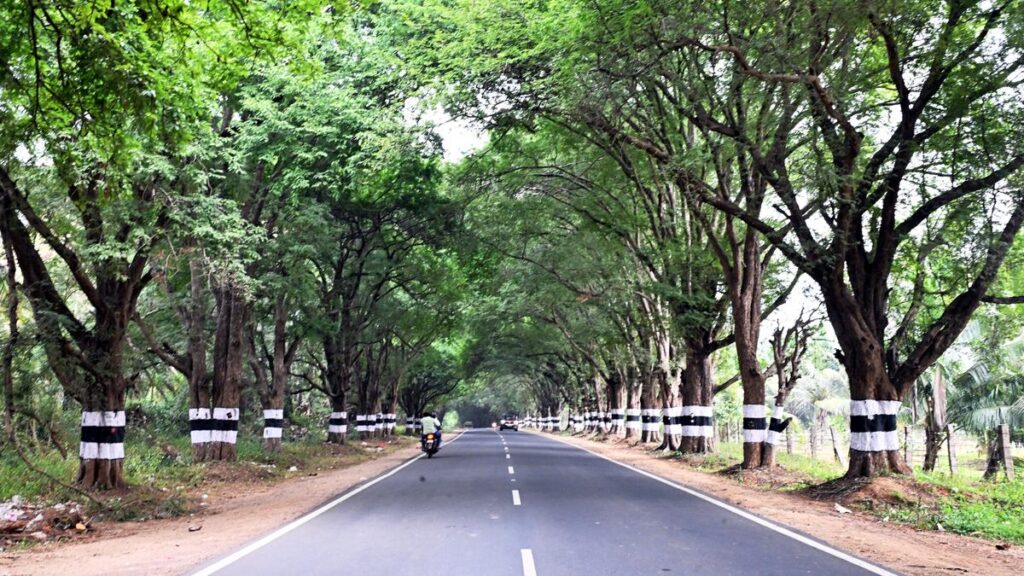These trees came as immigrants, made friends with the locals and now are upstanding inhabitants of Coimbatore providing priceless service to the city and its people.
Architect, Jayashree Raman says trees offer a wealth of natural solutions to various design challenges. “They provide insights into structural strength, energy efficiency, and biomimicry, leading to more sustainable and aesthetically pleasing designs.”
For example, Spanish architect Santiago Calatrava created spaces that were as enduring as the trees that had inspired his designs. Calatrava learnt from the wisdom of Nature and his design philosophy served human needs as well as the environment’s.
But design is not just the business of architects; it concerns everyone, says Jayashree. “So why can’t we look at trees in our neighbourhood and see what lessons we can take away from them,” she asks during a tree walk curated by her and fellow architects Sai Vivek, Udhaya Vauhini and Cibi Veeramani, in association with The Indian Institute of architects, Coimbatore Centre. The walk was part of an initiative called The Design Mill.
“The Design Mill wants to create a community in Coimbatore that meets and has conversations about design in everyday life,” says Jayashree, who wants to learn about and document Coimbatore’s trees.
For the walk, the Design Mill team selected trees that have been part of the landscape for at least 200 years, including ones that have been around for thousands of years.
Home and away
The endemic Pongai tree (Pongamia glabra) is a familiar fixture in the Tamil landscape, and finds mention in the ancient Sangam literature. “Its leaves are often kept along with grains to repel insects, and oil from its seeds is used to light lamps,” says Jayashree. A hardy, erosion-preventing tree with a broad canopy, Pongai is well-suited to arid, saline environments and is often found lining roads and villages
Like people from time immemorial, many of the trees have also travelled from faraway lands. The Gulmohar tree (Delonix regia), for instance, was confined to Madagascar until the 19th Century. Now it is a firm favourite with its flaming orange flowers. Madagascar may be its birth place, but the Tamils have embraced it as their own and even given it a local name, Mayil Kondrai (peacock’s crown).

The Design Mill’s tree walk in Coimbatore
| Photo Credit:
Special Arrangement
The Cannon Ball tree (Couroupita guianensis) has also become part of local lore. The tree, locally called Nagalingam, is sacred and represents Lord Shiva, though it came to India from the tropical rainforests of Central America. Its large, flamboyant flower, which grows directly on the bark, has petals with a centre that resembles a lingam (a short cylindrical pillar-like symbol of Shiva)
Another guest that decided to stay on is the Brazilwood tree, (Guaiacum Officinale) also known as the Lignum Vitae or wood of life as it was believed to cure syphilis that ravaged Europe in the 16th Century. Incidentally the wood of the tree is considered to be one of the densest in the world and it sinks in water.
The Design Mill’s book recommends
Trees of Delhi: A Field Guide by Pradip Krishen
Iconic Trees of India by S Natesh with illustrations by Sagar Bhowmic
Pillars of Life: Magnificent Trees of the Western Ghats by Divya Mudappa and TS Shankar Raman with Botanical illustrations by Nirupa Rao and sketches by Sartaj Ghuman
Next, we walk straight into the heady fragrance of the Plumeria or the Frangipani. The smooth, elegant tree with its white, pink and yellow flowers is also from Central America and has been around for a few hundred years in India. Not too far is the Autograph tree (Clusia Rosea) and everyone rushes to scribble their initials on its waxy leaves.
The Badminton Ball tree (Parkia Biglandulosa) travelled here in the 16th century from East Asia. “It is like a pollinator cafe,” says Jayashree because it nourishes birds and bees during the day and bats at night.
We admire the romantically named raintree that has a rather unromantic Tamil name. It is called Thungumoonji maram or the sleepy-faced tree as its leaves close in on themselves when it rains and in the evenings.
Making connections
For all those who had forfeited the Sunday morning sleep in, it was a couple of hours well spent. What could be more therapeutic than walking under the shade of trees, standing under the fantastically wrought branches and staring at the fruits and flowers and breathing in their woody smells.
“I know that these kinds of public engagements definitely help in improving the general awareness of the bounty of Nature,” says tree walker Padmaja Sundar, who recently moved to Coimbatore from Chennai. She describes herself as a foot soldier of Nizhal, a Chennai-based NGO that is involved in urban greening with trees that are indigenous to the region. Padmaja is looking forward to involving herself in greening initiatives in Coimbatore.

The Design Mill’s tree walk in Coimbatore
| Photo Credit:
Special Arrangement
The Design Mill has set out to do just this, says Jayashree.
“The idea is to collaborate with other studios, organisations and resource people. It is a great opportunity for us to meet and learn from experts from other disciplines and get inspired,” adds Udhaya.
As the group moves from tree to tree, ideas flow. Most of those present confess that the opportunities to meet people face to face, engage in conversations and learn from each other are shrinking alarmingly. And the tree walk is one way of keeping human interactions alive and keeping in touch with the city spaces.
Published – May 01, 2025 08:08 pm IST

